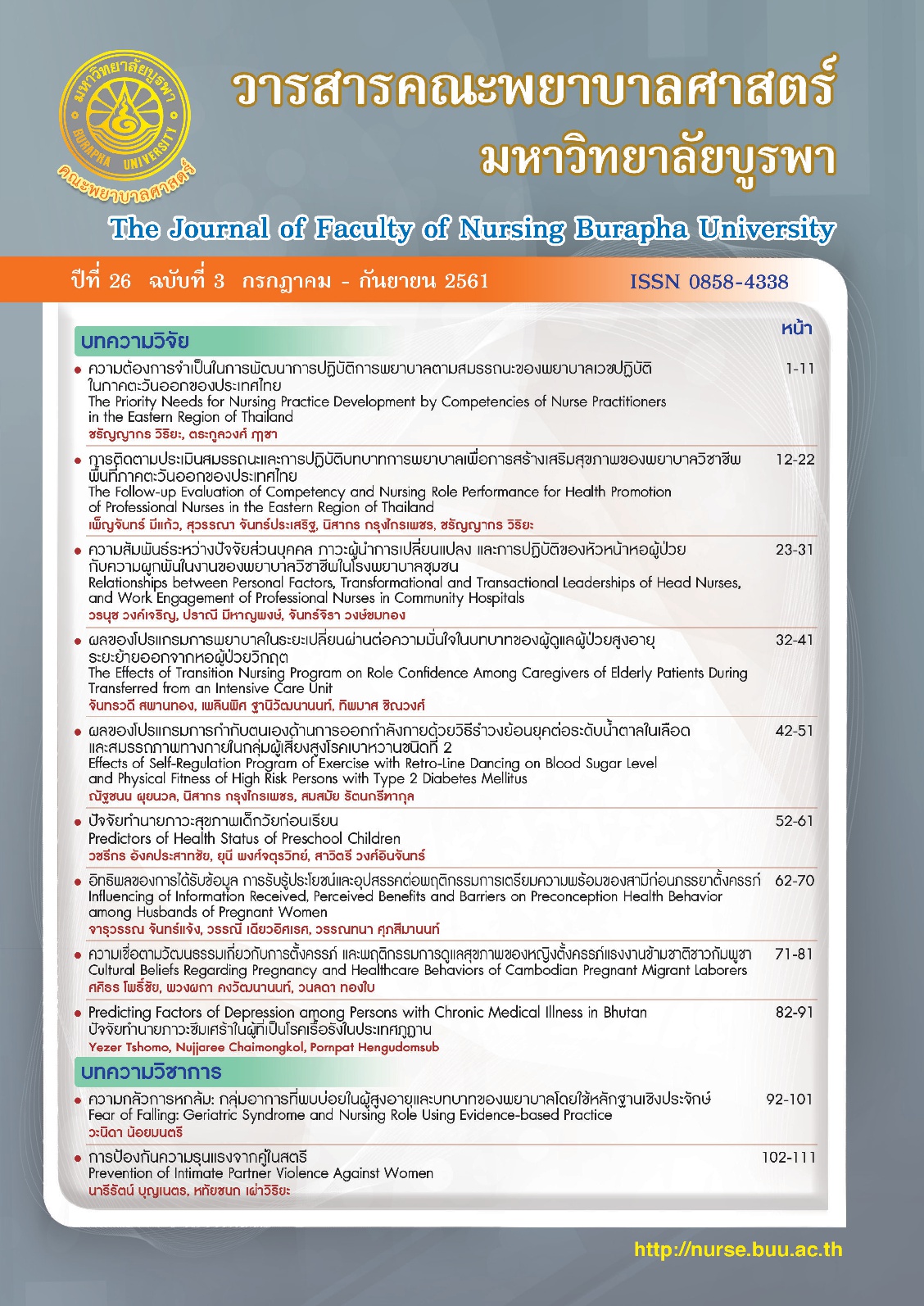ความกลัวการหกล้ม: กลุ่มอาการที่พบบ่อยในผู้สูงอายุและบทบาทของพยาบาลโดยใช้หลักฐานเชิงประจักษ์
คำสำคัญ:
ความกลัวการหกล้ม, การหกล้ม, ผู้สูงอายุ, กลุ่มอาการที่พบบ่อยในผู้สูงอายุ, หลักฐานเชิงประจักษ์บทคัดย่อ
บทคัดย่อความกลัวการหกล้มเป็นปัญหาสาธารณสุขที่สำคัญในประชากรผู้สูงอายุ และเป็นหนึ่งในกลุ่มอาการที่พบบ่อยในผู้สูงอายุ ความกลัวการหกล้มในระดับที่มากเกินไปในผู้สูงอายุสามารถนำไปสู่การจำกัดกิจวัตรประจำวัน การแยกตัวไม่เข้าร่วมกิจกรรมทางสังคม ซึ่งทำให้เกิดความเสื่อมถอยสมรรถภาพทางร่างกาย หรือภาวะทุพพลภาพตามมา ผู้สูงอายุบางรายอาจมีภาวะซึมเศร้า และทำให้ความพึงพอใจในชีวิตลดลง พยาบาลมีบทบาทสำคัญในการคัดกรอง และให้การดูแลผู้สูงอายุที่มีความกลัวการหกล้มโดยใช้หลักฐานเชิงประจักษ์ บทความนี้ผู้เขียนมีวัตถุประสงค์เพื่อนำเสนอปัญหาความกลัวการหกล้มซึ่งเป็นปัญหาที่พบได้บ่อยในผู้สูงอายุแต่ยังขาดการจัดการเพื่อลดปัญหาดังกล่าวอย่างจริงจังจากบุคลากรทางสุขภาพเท่าที่ควร และเพื่อกระตุ้นให้พยาบาลเห็นความสำคัญในการประเมินความกลัวการหกล้มในผู้สูงอายุ และให้การพยาบาลโดยใช้หลักฐานเชิงประจักษ์
เอกสารอ้างอิง
Austin, N., Devine, A., Dick, I., Prince, R., & Bruce, D. (2007). Fear of falling in older women: A longitudinal study of incidence, persistence, and predictors. Journal of the American Geriatrics Society, 55, 1598-1603. doi:10.1111/j.1532-5415.2007.01317.x
Beyea, S. C., & Slattery, M. J. (2006). Evidence-based practice in nursing: A guide to successful implementation. Marblehead, MA: HCPro.
Campbell, A. J., & Robertson, M. C. (2003). Otago exercise programme to prevent falls in older adults: A home-based, individually tailored strength and balance retraining programme. Otago Medical School University of Otago, New Zealand.
Chang, H. T., Chen, H. C., & Chou, P. (2016). Factors associated with fear of falling among community-dwelling older adults in the Shih-Pai study in Taiwan. PLoS One, 11, e0150612. doi:10.1371/journal.pone.0150612
Cumming, R. G., Salkeld, G., Thomas, M., & Szonyi, G. (2000). Prospective study of the impact of fear of falling on activities of daily living, SF-36 scores, and nursing home admission. The Journals of Gerontology. Series A, Biological Sciences and Medical Sciences, 55, M299-305.
Delbaere, K., Crombez, G., van Haastregt, J. C., & Vlaeyen, J. W. (2009). Falls and catastrophic thoughts about falls predict mobility restriction in community-dwelling older people: A structural equation modeling approach. Aging & Mental Health, 13, 587-592. doi:10.1080/13607860902774444
Department of Provincial Administration. (2016). The national statistics on Thailand’s population of the year 2016. Retrieved from http://stat.bora.dopa.go.th /stat/statnew/statMenu/newStat/sumyear.php (in Thai)
Deshpande, N., Metter, E. J., Bandinelli, S., Lauretani, F., Windham, B. G., & Ferrucci, L. (2008). Psychological, physical, and sensory correlates of fear of falling and consequent activity restriction in the elderly: The InCHIANTI study. American Journal of Physical Medicine & Rehabilitation, 87, 354-362. doi:10.1097/PHM.0b013e31815e6e9b
Friedman, S. M., Munoz, B., West, S. K., Rubin, G. S., & Fried, L. P. (2002). Falls and fear of falling: Which comes first? A longitudinal prediction model suggests strategies for primary and secondary prevention. Journal of the American Geriatrics Society, 50, 1329-1335.
Lapanantasin,S., Techovanich, W., Na Songkhla, P., Odglun, Y., & Wikam, S. (2015). Balance performance and fear of fall improvement for elderly women living in Ongkharak and Bang-lookseir subdistrict of Nakhonnayok province by a community-based service. Thai journal of physical therapy, 37, 63-77. [In Thai]
Naik, A. D., Concato, J., & Gill, T. M. (2004). Bathing disability in community-living older persons: Common, consequential, and complex. Journal of the American Geriatrics Society, 52, 1805-1810. doi:10.1111/j.1532-5415.2004.52513.x
National Council on Aging. (2018a). Program summary: A matter of balance. Retrieved from https://www.ncoa.org/resources/program-summary-a-matter-of-balance/
National Council on Aging. (2018b). Infographic: Tai Chi: Moving for better balance classes in Colorado. Retrieved from https://www.ncoa.org/resources/sample-brochure-oregon-senior-falls-prevention-program/
National Council on Aging. (2018c). Otago exercise program: Program information and guidance. Retrieved from https://www.ncoa.org/resources/otago-exercise-program-program-information-guidance/
Noimontree, W. (2017). Fear of falling in older adults: A trajectory analysis (Doctoral dissertation). Available from ProQuest Dissertations and Theses database. (UMI No. 1492016857).
Phongphanngam, S. (2015). Fear of falling and disability among Thai community-dwelling older adults (Doctoral dissertation). Available from ProQuest Dissertations and Theses database. (UMI No. 10003044).
Sririphanich, B. (2016). Situation of the Thai elderly 2016. Bangkok: Foundation of Thai Gerontology Research and Development Institute.
Talley, K. M., Wyman, J. F., Gross, C. R., Lindquist, R. A., & Gaugler, J. E. (2014). Change in balance confidence and its associations with increasing disability in older community-dwelling women at risk for falling. Journal of Aging and Health, 26, 616-636. doi:10.1177/0898264314526619
Tennstedt, S., Howland, J., Lachman, M., Peterson, E., Kasten, L., & Jette, A. (1998). A randomized, controlled trial of a group intervention to reduce fear of falling and associated activity restriction in older adults. The Journals of Gerontology. Series B, Psychological Sciences and Social Sciences, 53, P384-392.
Thiamwong, L., & Suwanno, J. (2017). Fear of falling and related factors in a community-based study of people 60 years and older in Thailand. International Journal of Gerontology, 11, 80-84. doi:https://doi.org/10.1016/j.ijge.2016.06.003
Yardley, L., & Smith, H. (2002). A prospective study of the relationship between feared consequences of falling and avoidance of activity in community-living older people. Gerontologist, 42, 17-23.





